|
The Esoteric Bach
By Thomas Braatz (April 2001) |
|
During this most solemn period in the Christian church calendar, a time when Bach was probably thinking about, composing, or preparing to perform one of his Passions, it seems appropriate to investigate an esoteric phenomenon relating to that most central Christian symbol, the cross. After a recent discussion here on the BCML, and mainly for anyone otherwise not acquainted with a suitable application of the word, 'esoteric,' to understanding Bach's life and his instrumental and vocal compositions, allow me to reiterate the best analogy that I can think of, namely, Bach's vocal music output as compared to Jesus' parables. Jesus related his parables to the masses as one of the preferred ways to instruct them about the spiritual truths he considered important, but for the deeper, hidden meaning behind these 'stories' he chose to speak only in private to his disciples (NT Mat 13:10-18). Likewise Bach conveyed his cantatas to his congregations in a form that allowed each individual to be moved aesthetically and spiritually while accepting Bach's musical message at a level that represented the receptive capacity of any given individual. Bach provided something for everyone, from the most erudite professors at the university to the simplest peasant that might happen to be visiting a large city church. Nevertheless, Bach's genius allowed for an even greater range or depth of understanding for those select individuals that knew him more intimately, as, for instance, those who actually performed the cantatas under his direction or those with whom he discussed the various techniques of composition and the books that he had been reading. It is also possible that he eventually came to the realization that even these latter individuals would or could not understand certain things and, as a result, he embedded some elements in his music that were left for future generations to decipher and understand. Bach loved to engage in musical puzzles such as unique fugal subjects and canons, and the challenge that such puzzles posed must have been a source of great joy to him as in his Musical Offering, BWV 1079 |
|

|
|
(where, in one piece, two players facing each other read the same piece of music from the same score, one player beginning where the other has the conclusion and vice versa - they meet in the middle), the musical puzzle in the form of a cross, often included in the liner notes to the Suzuki cantata series |
|
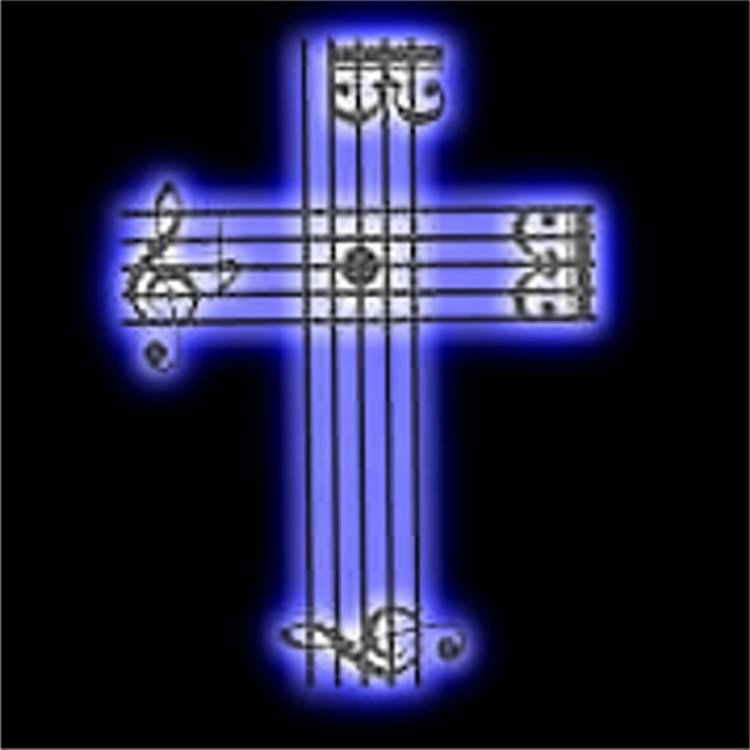
|
|
(), or his own monogram/seal (see the following link http://jan.ucc.nau.edu/~tas3/crownofthorns.html to decipher his monogram and remember to count the tiny extensions (except the two spikes on which the crown would come to rest.)) He also must have taken great pleasure, as many great minds do, in speaking "durch die Blume" = "to speak indirectly, through allusion, using innuendo." This allowed for a type of 'punning' or 'double entendre' where the ambiguity becomes a protective shield (you wouldn't want Bach to get involved in another one of those encounters, such as the one he had with Geyersbach, a bassoonist, whom Bach had called a "Zippel-fagottist"='nanny-goat bassoonist', a derogatory term, whereupon Bach had to draw his sword in order to protect himself ). As I was working on this report, I had to laugh out loud as I made a connection between the name of the cantata BWV 193 Ihr Tore zu Zion and the occasion for which it was written: the inauguration of the city council members. Why is this funny? Because the city elders in their pomp and circumstance are thinking biblically, "Ye Gates of Zion" while Bach is thinking, "You Fools of Leipzig." (Remember also that these were the elders that said that Bach was 'inkorrigibel', a nice foreign sounding word in German, but we know it in English as 'incorrigible.') This punning is possible because the word, "Tor" can mean both things in German. But Bach's puns were not only on a word level. Simply think of the musical representation of his last name in Contrapunktus 14 of the AOF (BWV 1080) and the example already cited (see: Puzzle A), the 'Bach in the form of a cross' puzzle where he represents himself with a single note in the middle of the cross, a very clever idea! Then there is the puzzle |
|

|
|
that Bach submitted to Mattheson, who reports on it in his "The Complete Kapellmeister" and states that he received this puzzle from Herr Bach on such and such a date in 1727 and immediately after identifying it as a 'circle fugue' submitted it to his students - Mattheson never reports his solution, but rather prints two suggested solutions by two men, one of whom had already died without ever finding out, if his suggested solution was acceptable. Mattheson could not tell him, because only Bach had the correct answer in mind. If I mentioned Bach's number symbolism at this point, I would certainly be digressing and not returning to the point that I wish to discuss in detail: the cross.
Among a number of meanings that the word, "Kreuz"=[cross] can have in German are two very important ones: 1) the cross on which Jesus Christ died and 2) the musical definition of a notational sign, the 'sharp,' which, when placed before a note, causes it to be raised in pitch by a semitone. In German the 'sharp' is called 'das Kreuz' and a 'double sharp' which causes the pitch to be raised by two semitones, is called in German 'das Doppelkreuz.' Let me try to simplify that somewhat: The '#' symbol that you see in a score is a 'sharp' in English, but any speaker of the English language would not know that in a Bach score it may have an additional meaning beyond raising the note by one semitone, since it can also mean 'cross' with all of its religious symbolism as Bach stated in one of his letters:" "...so muß [ich] mein Creütz in Gedult tragen..." Leipzig 24.5.1738 = "I must bear my cross with patience." Hence # = Cross = "Kreuz."
In the MGG Vol. 1 Col. 1300 in the article by Friedrich Blume on the Baroque Period in music, he states: "Wenn Bach in der Kirchenkantate BWV 56 (Ich will den Kreuzstab) zahlreiche Hochalterationen (#) notiert, so ist dies ein Fall reiner Symbolik, denn diese Zeichen können nicht "gehört" und somit nicht unmittelbar "verstanden" werden; sie müssen "gelesen" und "gewußt" werden, wobei die reine Sinnbildlichkeit dieser "Zeichengebung" (darauf hat Bukofzer aufmerksam gemacht) in diesem Falle besonders evident wird, weil nur in der deutschen Sprache # = Kreuz ist, das Symbol also aus der Musik mit einer fremdsprachlichen Übersetzung gar nicht nachvollzogen werden kann. A rough translation: [In the situation where Bach uses numerous #-accidentals in the sacred cantata BWV 56 (Ich will den Kreuzstab), it can be considered a case of pure symbolism, because these accidentals (the 'sharp' signs = #) can not be 'heard' and as a result they can not be understood directly, but rather must be 'read' and 'known' , a fact that becomes quite evident because of the plain symbolism that arises through assigning meaning to a musical sign (a feature that Bukofzer has pointed out). This can only happen by virtue of the fact that, in the German language, the meaning of the symbol derived from musical terminology, a '#' = cross, can not be transferred to any other language.] So what we have here, as I attempt to extract meaning from this statement, is a sprinkling of sharps strewn through the cantata and that could be considered evidence of Bach's attempt at symbolism. A rather vague statement of a possible connection. Alfred Dürr, in his "Bach: Die Kantaten" does not mention anything about this. David Schulenberg in his article about this cantata in the 'Oxford Composer Companions: J.S.Bach [M.Boy]' also refers to the "chromatically sharpened fourth note of the ritornello theme" just as Kerr did, but he does mention the "word 'Kreuzstab' makes explicit the pun on this word ('Kreuz' means both 'sharp' and 'cross')."
I had a feeling that there must be more to this, because I vaguely remembered seeing another instance in another cantata as I followed the score of each cantata while listening to the various recordings. However, I had not marked it, and had forgotten in which cantata it was, and yet I wanted to find it again quickly. My next thought was to go to the suggested internet site (Walter F. Bischof's Site) that had the complete text in German of all the sacred cantatas. It also had a handy search engine, that allowed me to input 'Kreuz' and come up with fifty some odd instances of this word. Now it was simply a matter of rolling up my sleeves and 'digging in' in order to find an answer.
As I began looking at a few examples in the scores of the first cantatas in the list, I realized that certain conditions would need to prevail, in order to find a significant example where it would appear that Bach intentionally used the #='Kreuz'='cross' feature when the word 'Kreuz' appeared in the vocal line. Here are some considerations that evolved as I began placing the examples into one of the two categories: 1) it meets the criteria or 2) it fails because there are some reasonable grounds that preclude its use in certain situations.
Here are some of the reasons that evolved early in the search process, reasons that make sense to me, although others might simply think that they are rationalizations on my part:
1) The word "Kreuz" in the chorale melody is not a good candidate for this type of associative symbolism because a) in an introductory chorale movement, the melody based on an already existing musical structure is frequently given long note values with the other vocal parts often repeating the same word in fast succession; b) in the introductory and concluding chorale movements in a sacred cantata, the first line is most often repeated with different words the second time through, but the music remains the same - a degradation of significance occurs when other words replace "Kreuz" in its otherwise unique position in the music.
2) When the word "Kreuz" is placed in an unaccented position, the emphasis in the text being elsewhere on a different word usually following it, it rarely shows the #-connection sought after.
3) Following from this consideration is the fact that "Kreuz" used as another part of speech, for example, particularly as an adjective, or in a compound noun (and the German language loves to combine elements of this sort!) weakens the emphasis on the key word "Kreuz" in many instances, because the first element "Kreuz" begins to act like an adjective to the second noun in the compound.
4) the value of the note can be too slow or too fast for a proper emphasis to occur, thus a quarter note (sometimes a half note) seems to be ideal, but eighth and sixteenth notes too fast for any proper emphasis to occur.
5) The first note in a measure seems to be an ideal spot for the word "Kreuz" to receive a full emphasis.
6) More often than not, and particularly in recitatives, the # is in the basso continuo and not in the vocal part, a phenomenon that at first took me by surprise.
7) Although the search for "Kreuz" in the cantata German text database may turn up one or two instances in a given movement, particularly in an aria, the word may reoccur many times within the same aria, thus depleting any emphatic effect the word might have when connected with a '#'. It might, however, happen that the very first instance of "Kreuz" in such an aria will nevertheless have this emphasis or connection.
Somewhere at the beginning of this process while trying to determine when Bach uses the double sharp in the cantatas, I discovered that the words "Höll-" and "Wurm" ('hell' and 'worm') had an unusually affinity for sharps and double sharps. Although not as convincing as the preponderance of evidence with "Kreuz", I have included them and marked them accordingly. Many of the considerations that apply to "Kreuz" can also be applied here. With "Wurm" I considered the possibility that this word describes (for the musician playing or singing it) the enharmonic movement, 'worming one's way' into another key. The extremely few instances of this word in Bach's cantatas make it very difficult, if not impossible, to say anything very meaningful about this connection, if it exists at all.
Before listing the examples with my commentary, I would like present some imaginative scenarios that might give possible explanations for Bach's motivation in frequently applying sharps and double sharps in a specific way:
1) Remembering that, more often than not, the only performing musicians, with the exception of the complete score that Bach had before him, to see the "#" were the continuo players, and the vocalists singing the word "Kreuz" may not even see a sharp before the note that "Kreuz" is sung on. For that matter, neither does the congregation/audience. Three explanations come to my mind and they are a) Bach felt he was 'erecting/lifting up' the 'cross' musically on the foundation supplied by the continuo part. This type of musical picture imaging is not that far-fetched, when you consider that Mattheson ("The Complete Kapellmeister") explains that 'every fugue has two "Haupt-Kämpfer" = main warriors/fighters that have to contend with each other.
2) Bach may have had to contend with student musicians that were not on an equally high level of proficiency. It sometimes happened that a student in his charge (we have Bach's evaluations and letters of recommendation as proof) should not sing because he was not musically proficient in that area, but rather play an instrument instead. Take such a student player and give him the bass part (cello, bassoon, or violone) that would not be as difficult as any other instrument, or have someone like Johann Heinrich Geyersbach playing the continuo-bassoon, either of these individuals simply 'chugging away' in a plodding, unthinking manner at a musical part placed before them, and now have Bach deliberately throw in a note with a sharp, the only one in the entire movement. What happens? Bach only has to give this individual a knowing look at the very moment that the vocalist sings "Kreuz," because the word that will solve the problem of the wrong note has already been stated by the vocalist. At the same time the player is correcting the note, he will also perceive what a burden/cross his oversight has been for Bach. Or Bach is simply trying to wake up the individual playing to think both of the significance of the 'cross' in one's life as identical with the 'cross' seen on the copy of the part: "Lift up your cross, that is, raise the note one semitone, then you will be in harmony with the rest of us."
3) Another possibility that I am exploring is the meaning of the 'cross' as something difficult, not only in the lives of the musicians, but also for those who are listening, if they are actually hearing this performance in a modified mean tone, a situation that I am beginning to think is quite possible. Then this word "Kreuz" would be the very point where the jarring nature of the sound becomes most apparent. Perhaps there was the greatest likelihood of a musically uncomfortable sound on F# and C#, the very notes that Bach prefers to use as he underlines the connection between Christ's cross and the imperfect world upon which it was erected, in this case it is also the imperfect temperament that caused a jarring sound to appear at the very point where the voice sings the word 'cross.' For Bach, this would be like an organist pulling a special stop that creates just the right effect to musically illustrate the word that is being sung.
Following is a list of occurrences in the cantatas according to their performance date (Oxford Composer Companions: J.S.Bach - Boyd). It becomes apparent thatBach's early cantatas only occasionally follow the standard that I have established, only later on can the best examples be found. This in itself makes sense and can allow for the early instances in Bach’s cantata output to be discounted, thus allowing us to see even better, that Bach uses this compositional technique intentionally.
Some tentative conclusions: Here we find further evidence of Bach's all-pervading genius whether it takes on the form of a pun with a very serious aspect to it, or whether it is trying to make use of every musical possibility at its disposal. In the latter case, where the question of equal or not equal temperament being available to Bach at all times can not be definitively answered (an attempt by R. Rasch in 1985 was made to try to put this matter to rest with exhaustive research, and yet many, including myself, are not fully convinced that this was entirely the case). I, for one, would like to hear a performance/recording of one of cantatas listed above, having good examples of 'Kreuz' und 'Hölle' in it, and also using an unequal, modified meantone temperament. I will have to assume that the organs Bach played in Leipzig did not have all the F#, C# etc., pipes reworked or replaced in order to make them entirely suitable for equal temperament, nor would Bach have taken the time immediately before a performance or a given movement in a cantata to 'retune' certain pipes for a short time, after which they would have to be retuned again quickly. If Bach then intentionally put an F# in the continuo part where a keyboard (mainly organ) player would clash with the bass string/bassoon player beside him, while the singer is projecting the word "Kreuz" to the congregation, the listeners would also have heard this clash backing up the meaning that they associated with "Kreuz." But until such a recording is made and the results become evident to the listener, we will have to consider the "Kreuz" phenomenon in Bach's cantatas to be esoteric in nature. |
|
© Thomas Braatz 2001 |
| |
|
Pre-Weimar 1704-1708 |
|
BWV 150 Nach dir, Herr, verlanget mich Mvt. 3 Soprano Aria Doch bin und bleibe ich vergnügt "Kreuz" and "Höll" frequently repeated with not much of a chance for special emphasis No example given. |
|
BWV 4 Christ lag in Todes Banden Mvt. 6 Bass Chorale Verse Hie ist das rechte Osterlamm
A little different than we might come to expect. It is an early work. The first time Bach does nothing with "Kreuzes", but the second time he 'pulls out all the stops' Here you see all the repeated instances on one page. Notice all the sharps - G#, C#, A#, E# in one measure!
|
|

|
| |
|
Weimar 1714-1716 |
|
BWV 182 Himmelskönig, sei willkommen Mvt. 6 Tenor Aria Jesu, laß durch Wohl und Weh
The compound noun, "Kreuzpanier" has a very different meaning here, as having a protective quality, and should be discounted for that reason. But when the world cries out, "Crucify" = "Kreuzige" in both instances Bach raises the cross on the continuo with F# in the vocal line. Compare side by side the two selections and notice that these examples are not simple duplicates of each other, that is, the cross is raised on different notes. |
|

|
| |
|
BWV 12 Weinen, Klagen, Sorgen, Zagen Mvt. 4 Alto Aria Kreuz und Kronen sind verbunden, Kampf und Kleinod sind vereint
The very positive association of "Kreuz" with its reward seems to have removed the idea of trying to 'erect' the cross. Nothing happens here: |
|

|
|
Mvt. 5 Bass Aria Ich folge Christo nach the word "Kreuz" occurs twice in an unaccented position. Two closeup examples on one page |
|

|
| |
|
BWV 21 Ich hatte viel Bekümmernis Mvt. 5 Tenor Aria Bäche von gesalznen Zähren
In the key of Eb in an unaccented position. The downward motion is more important. Perhaps the word 'Schlund' is significant because it has a Gb. |
|

|
|
Mvt. 9 Chorus Chorale Sei nun wieder zufrieden has one instance in the melody line but nothing happens. Is it because of the long note values (tenor voice has the "Kreuz") that the emphasis is not so strong? |
|
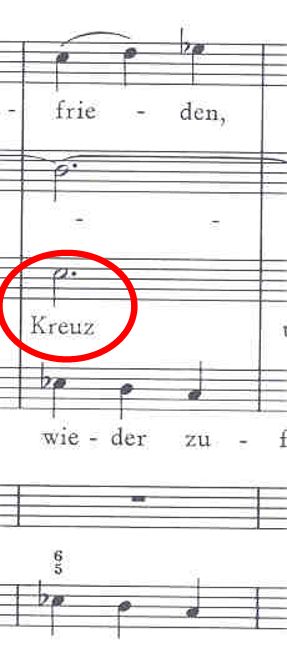
|
| |
|
BWV 199 Mein Herze schimmt im Blut Mvt. 1 Soprano Recitative
The compound noun, "Höllenhenker" appears in the middle of the measure. No special marking in this early work of Bach's. |
|

|
| |
|
BWV 152 Tritt auf die Glaubensbahn Mvt. 3 Bass Recitative Der Heiland ist gesetzt
Here it is part of a musically descriptive falling into hell; it is in the middle of a measure (Ab) and not under main emphasis. |
|

|
| |
|
BWV 31 Der Himmel lacht! Die Erde jubilieret Mvt. 3 Bass Recitative Erwünschter Tag
Even in this unaccented position, the C#'s appear. |
|

|
|
Mvt. 4 Bass Aria Fürst des Lebens
The phrase "the ladder of the cross lifts you" has "Kreuz" in an unaccented position as part of a potential compound noun, but there are two F#'s in the vicinity. Not a good example. The interest here is in establishing the upward movement. |
|
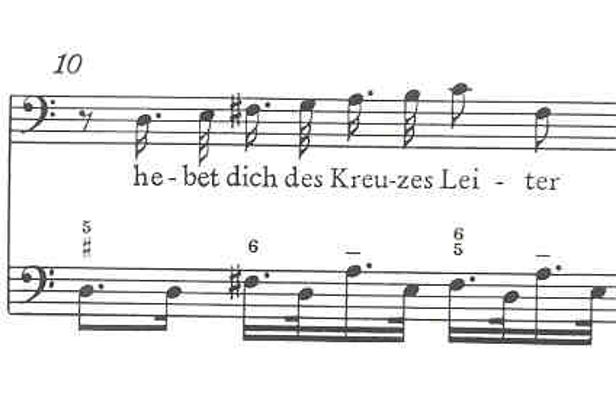
|
| |
|
BWV 165 O heiliges Geist- und Wasserbad Mvt. 4 Bass Recitative Ich habe ja, mein Seelenbräutigam
The word "Kreuz" appears at the end of the measure in an unaccented position and the greater emphasis is more directly upon the serpent that is being raised on the already standing cross. |
|

|
| |
|
BWV 162 Ach! ich sehe, itzt, da ich zur Hochzeit gehe Mvt. 1 Bass Aria
"Hölle" and "Höllenflammen" both appear twice in the aria. The word, "Hölle" is unaccented and shows nothing, but the compound noun "Höllenflammen" does have an F# in the continuo. |
|

|
| |
|
Leipzig Probe 1723 |
|
BWV 22 Jesus nahm zu sich die Zwölfe Mvt. 3 Bass Recitative Mein Jesu, ziehe mich
This is a verb, not a noun. Is Bach still trying to raise the note on "kreuzige" as if it were a sharp, but here a natural instead? An Ab in the continuo. |
|
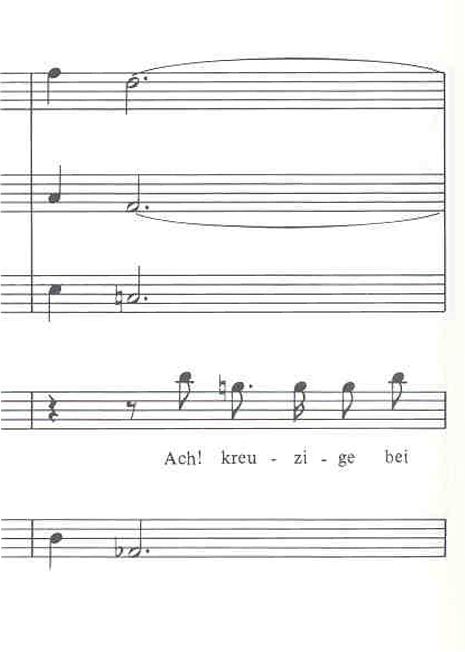
|
| |
|
1st Leipzig Year 1723-4 |
|
BWV 75 Die Elenden sollen essen Mvt. 2 Bass Aria Was hilft des Purpurs Majestät, da sie vergeht
"Hölle" is on the second strong accent descending to hell as it were. The D# appears in the vocal line. |
|
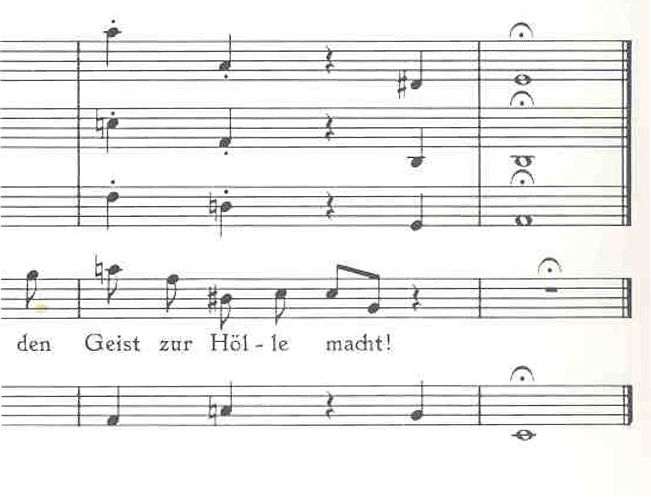
|
|
Mvt. 4 Tenor Recitative Gott stürzet und erhöhet
"Hölle" is here somewhat unaccented in the middle of the measure on very fast sixteenth notes - no #. |
|

|
| |
|
BWV 136 Erforsche mich Gott, und erfahre mein Herz Mvt. 2 Tenor Ach, daß der Fluch
This "Höllen" seems to break all the rules except for the fact that the continuo is 'standing' on an F# that the key signature demands anyway |
|
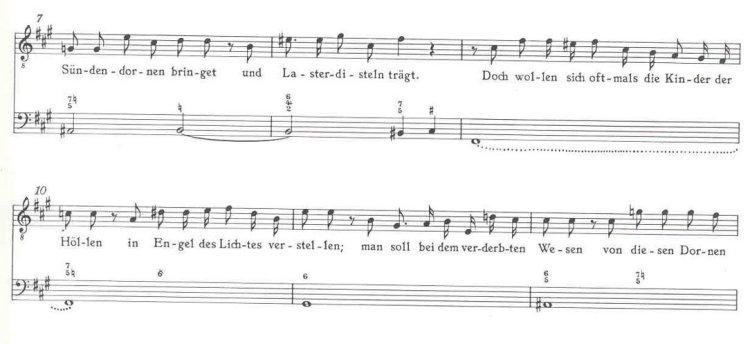
|
| |
|
BWV 105 Herr, gehe nicht ins Gericht Mvt. 4 Bass Recitative Wohl aber dem, der seinen Bürgen weiß
"Kreuze" is in the middle of the measure. Ab in the continuo |
|
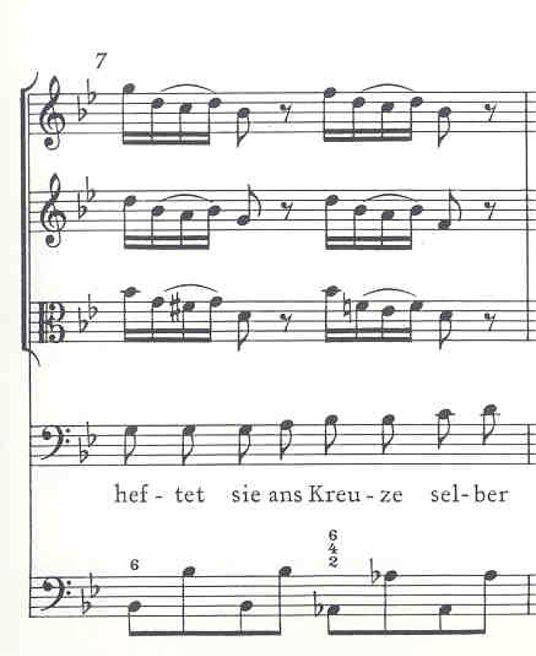
|
| |
|
BWV 48 Ich elender Mensch, wer wird mich erlösen Mvt. 2 Alto Recitative O Schmerz, O Elend, so mich trifft
Accented in the middle of the measure, the word "Kreuzkelch" has a continuo F#. |
|
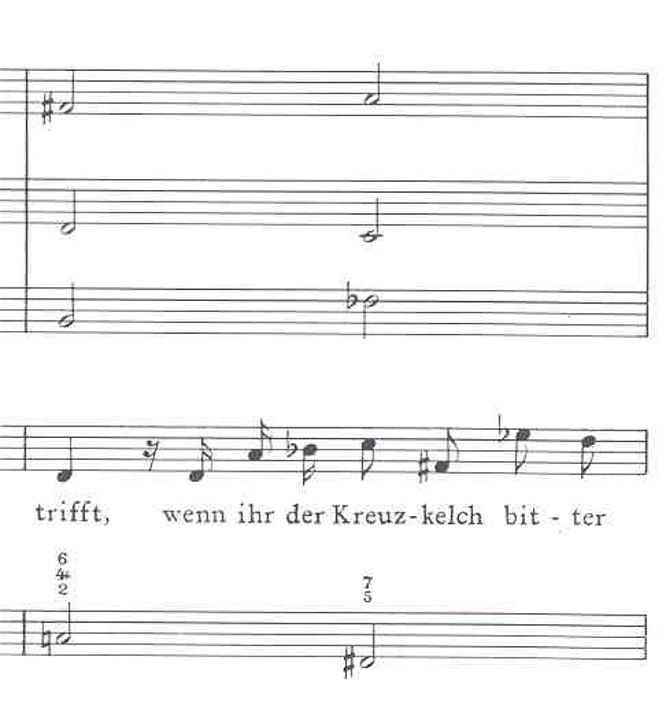
|
| |
|
BWV 89 Was soll ich aus dir machen, Ephraim Mvt. 6 Chorale Mir mangelt zwar sehr viel
Nothing here because it is in the chorale with a downward motion in the bass line. |
|
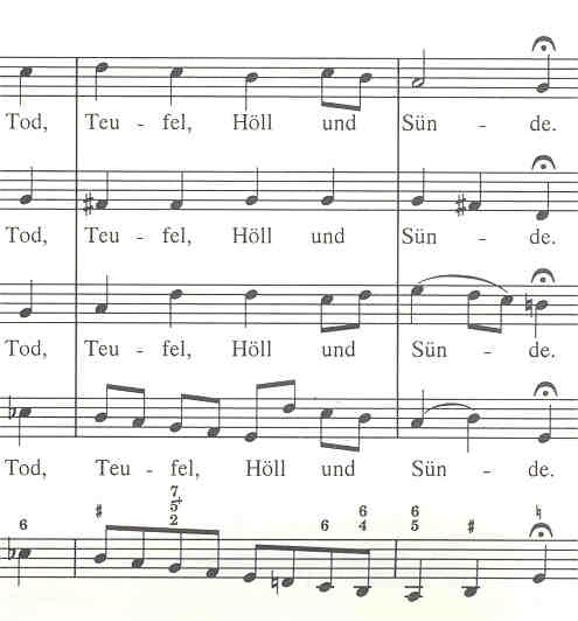
|
| |
|
BWV 60 O Ewigkeit, du Donnerwort Mvt. 4 Alto Bass Recitative Der Tod bleibt doch der menschlichen Natur verhaßt
"Höllenrachen" a compound noun with #'s all over. |
|

|
| |
|
BWV 70 Wachet! Betet! Betet! Wachet! Mvt. 9 Bass Recitative Ach, soll nicht dieser große Tag
"Höllenrachen" is in an unaccented position and is a compound noun. |
|

|
| |
|
BWV 40 Dazu ist erschienen der Sohn Gottes Mvt. 4 Bass Aria Höllische Schlange, wird dir nicht bange
As an adjective and unaccented. The main accent is on '' the high note in the phrase. |
|

|
| |
|
BWV 64 Sehet, welch eine Liebe Mvt. 6 Bass Recitative Der Himmel bleibet mir gewiß
"Höllenheer" in an unaccented position, and although is an A# before "Höllen" there are too many other sharps in this movement to make this significant. |
|

|
| |
|
BWV 153 Schau, lieber Gott, wie meine Feind Mvt. 8 Alto Aria Soll ich meinen Lebenslauf
"Kreuz" is in an unaccented position and receives no #, but "Höll" is in an accented position the G# is in the continuo while the voice is still singing the word "Kreuz" on an E#. |
|
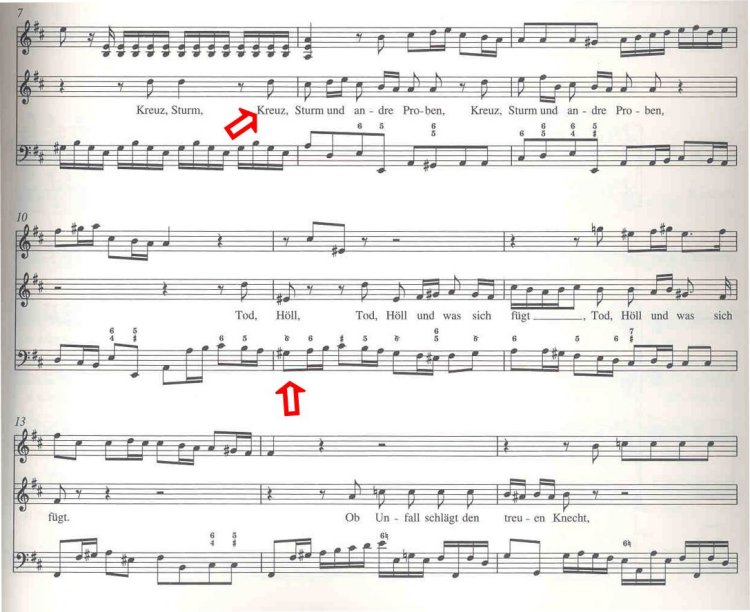
|
|
Mvt. 9 Chorale Drum will ich, weil ich lebe noch
In the middle of a chorale in an unaccented position and a repeated with other words position. |
|

|
| |
|
BWV 73 Herr, wie du willt, so schick's mit mir Mvt. 1 Soprano Recitative in choral movement.
Here Bach is more interested in demonstrating the musical direction downward into hell. No # here. |
|

|
| |
|
BWV 81 Jesus schläft, was soll ich hoffen Mvt. 7 chorale Unter deinen Schirmen
Even in a chorale (because the line is not repeated with other words?) in the accented position at the beginning of the measure a C# and A#. |
|

|
| |
|
BWV 181 Leichtgesinnte Flattergeister Mvt. 3 Tenor Aria Der schädlichen Dornen unendliche Zahl
Three instances of "höllischen" an adjective, not as powerful as having a noun, but one of the three shows E# in the continuo at the beginning of the measure. |
|

|
| |
|
BWV 134 Ein Herz, das seinen Jesum lebend weiß Mvt. 3 Alto and Tenor Recitative Wohl dir, Gott hat an dich gedacht
Two instances of "Hölle" both in the unaccented part of the measure but Db in the vocal part and Eb in the continuo. |
|

|
| |
|
BWV 67 Halt im Gedächtnis Jesum Christ Mvt. 3 Alto Recitative Mein Jesu, heißest du des Todes Gift
Although "Hölle" is in an unaccented position, look at the signature key and close by is the 'double cross' "Doppel Kreuz" in the continuo. |
|

|
| |
|
BWV 184 Erwünschtes Freudenlicht Mvt. 3 Tenor Recitative So freuet euch, ihr auserwählten Seelen
"Kreuzestod" is a compound noun but the sharps nevertheless appear at the end of the measure in an unaccented position - C# in the vocal part and A# in the continuo. |
|
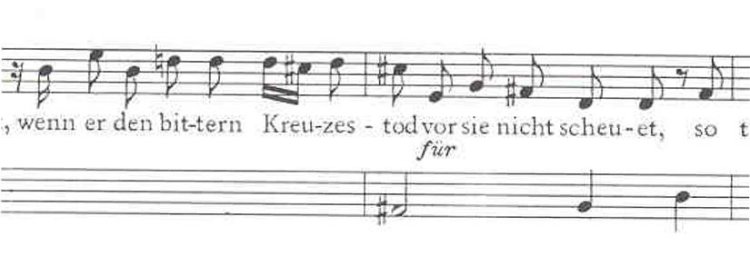
|
| |
|
2nd Leipzig Year 1724-5 |
|
BWV 20 O Ewigkeit, du Donnerwort Mvt. 3 Tenor Aria Ewigkeit, du machst mir bange
The direction downward in the vocal line is the overriding consideration. Also the aria is in the key of Bb. Nothing happens here – no # - no example given. |
| |
|
BWV 2 Ach Gott, vom Himmel sieh darein Mvt. 4 Bass Recitative Die Armen sind verstört
"Kreuz" on a Gb in vocal line at the end of the measure in an unaccented position. |
|

|
|
Mvt. 5 Tenor Aria Durchs Feuer wird das Silber rein
"Kreuz" appears as a stem form (not a compound noun) a total of 12 times! Any number symbolism here? Too many times to try to associate a # with each without losing significance, but there is one interesting sample that deviates from the usual presentation in this aria. It has a chromatic descent on "Kreuz" that begins with an F#. |
|

|
| |
|
BWV 7 Christ unser Herr zum Jordan kam Mvt. 6 Alto Aria Menschen, glaubt doch dieser Gnade
"Höllenpfuhl" From Bb to G# occurs in the vocal line on the word "Höllen". |
|
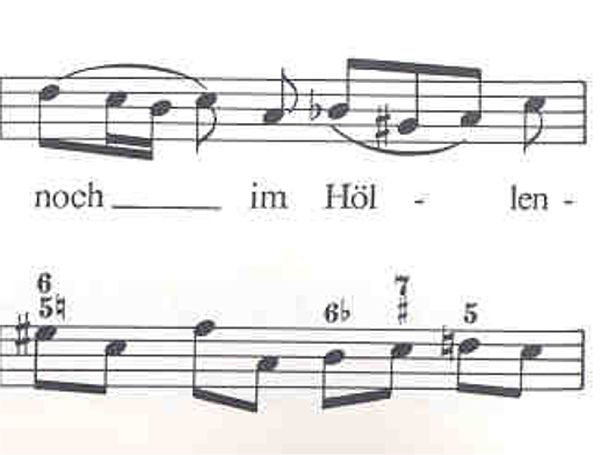
|
| |
|
BWV 135 Ach Herr, mich armen Sünder Mvt. 1 Chorus Chorale
"Höllenpein" a compound noun is in the bass line as the chorale melody with a long note value. |
|
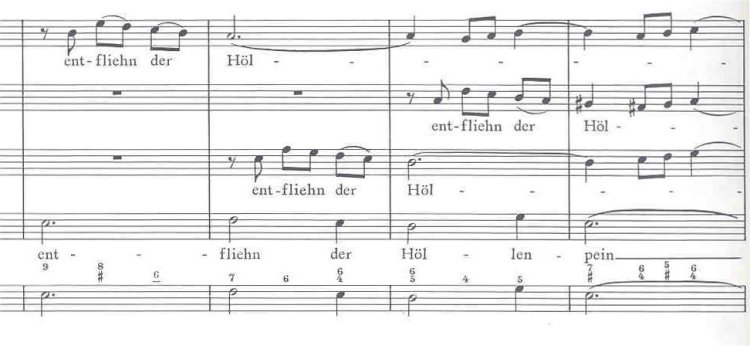
|
|
Mvt. 2 Tenor Recitative Ach heile mich, du Arzt der Seelen
One instance of 'Kreuz’ at the beginning of the measure, accented with A# in continuo. |
|

|
| |
|
BWV 93 Wer nur den lieben Gott läßt walten Mvt. 1 Chorus Chorale
"Kreuz" in the melody line where it appears with long notes - no # here. |
|
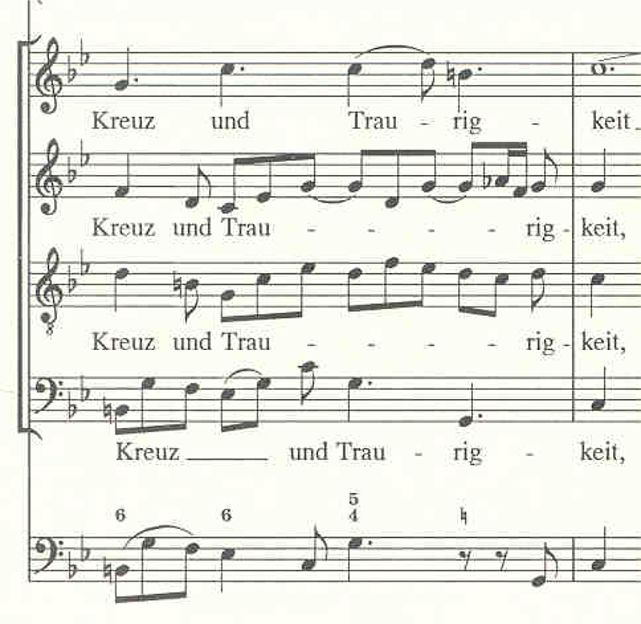
|
|
Mvt. 2 Bass Recitative Was helfen uns die schweren Sorgen?
"Kreuz" has a C# in the vocal part which then follows with an embellishment for further emphasis. It then appears in an unaccented postion the second time with no #. |
|

|
|
Mvt. 3 Tenor Aria Man halte nur ein wenig stille
Here it appears in a compound noun "Kreuzesstunde" = the hour of the cross. The emphasis on 'hour' is more important than 'cross' Nothing happens here for that reason. |
|

|
|
Mvt. 5 Tenor Recitative Denk nicht in deiner Drangsalshitze
In an unaccented position, no #, but an Eb. |
|
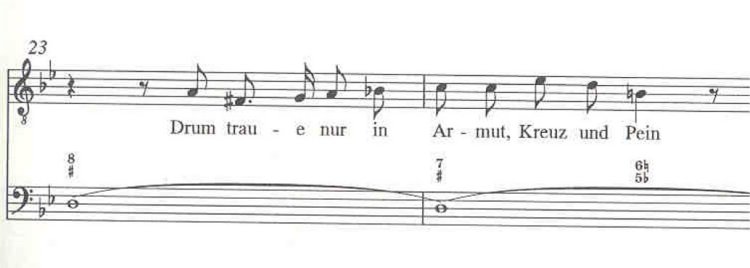
|
| |
|
BWV 107 Was willst du dich betrüben Mvt. 4 Tenor Aria Wenn auch gleich aus der Höllen
"Höllen" is repeated three times in rather quick succession. The first time is significant. The continuo already has an F# sharp and now the voice gets the D#. |
|
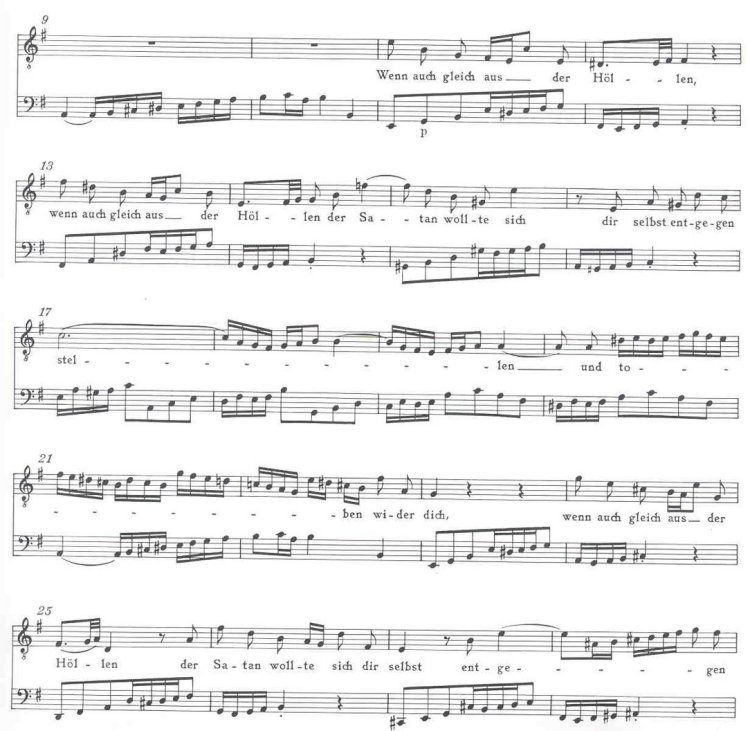
|
| |
|
BWV 178 Wo Gott der Herr nicht bei uns hält Mvt. 2 Alto Recitative Was Menschenkraft und -witz anfäht
The noun compound "Kreuzesmeer" is nevertheless given a C# in an accented position. |
|
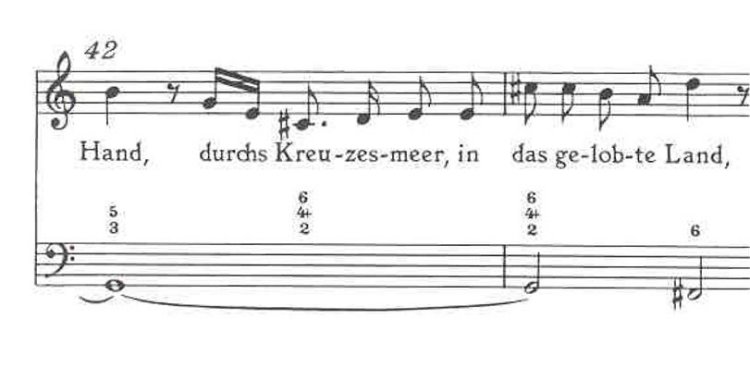
|
|
Mvt. 6 Tenor Aria Schweig, schweig, schweig
"Kreuz" is repeated seven times. The example shows four in quick succession - one does have a G# and the continuo also touches the G# while "Kreuz" ist still being sung. |
|

|
| |
|
BWV 94 Was frag ich nach der Welt Mvt. 3 Tenor Recitative Die Welt sucht Ehr und Ruhm
"Wurm" is in a compound "Erdenwurm" and is played as an F# because of the key signature. |
|

|
| |
|
BWV 78 Jesu, der du meine Seele Mvt. 4 Tenor Aria Das Blut, so meine Schuld durchstreicht
"Höllen" is accented in the middle of the measure and has an F# in the vocal part. |
|
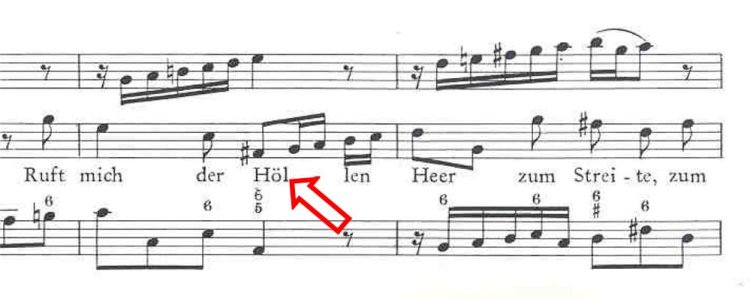
|
|
Mvt. 5 Bass Recitative Die Wunden, Nägel, Kron und Grab
"Kreuz" in this arioso has no special marking, perhaps because the cross is already in place from which the blood is shed. |
|

|
| |
|
BWV 99 Was Gott tut, das ist wohlgetan Mvt. 3 Tenor Aria Erschüttre dich nur nicht, verzagte Seele
The compound noun "Kreuzeskelch" appears in five instances, the first being the most important and showing the chromatic upward movement with a C#, D# in the vocal part still on the word, "Kreuz". |
|

|
|
Mvt. 5 Soprano Alto Aria Duetto Wenn des Kreuzes Bitterkeiten
There are 10 separate (sung at different times in both parts) instances - too many. The first two instances show a possibility of 'leaning' into the #'s by the oboe d'amore. |
|

|
| |
|
BWV 96 Herr Christ, der einge Gottessohn Mvt. 2 Alto Recitative O Wunderkraft der Liebe
"Hölle" here is a rule breaker: it is an Ab accented at the beginning of the measure as a single word (no compound). |
|

|
|
Does an Ab have the same effect as a G#? |
| |
|
BWV 5 Wo soll ich fliehen hin Mvt. 5 Bass Aria Verstumme Höllenheer
The compound noun "Höllenheer" has five instances in the unaccented portions of a measure. The example shows the first instance. |
|

|
| |
|
BWV 139 Wohl dem, der sich auf seinen Gott Mvt. 6 Chorale Dahero Trotz der Höllenheer!
In the first part of the chorale where other words are sung in the repeated section for the same notes - nothing expected here. |
|

|
| |
|
BWV 41 Jesu, nun sei gepreiset Mvt. 4 Mainly Bass Recitative Doch weil der Feind bei Tag und Nacht
In an ideal position, "Kreuz", accented as single word at the beginning of the measure with F# in the continuo and Eb in the vocal line. |
|

|
|
Mvt. 6 Chorale Dein ist allein die Ehre, where it is in the middle of a chorale, a section that is repeated with other words, also not in an accented position |
|
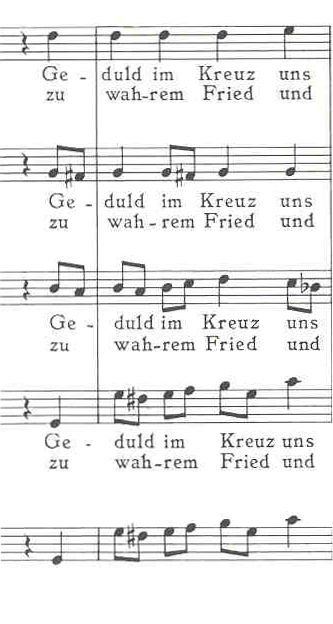
|
| |
|
BWV 123 Liebster Immanuel, Herzog der Frommen Mvt. 3 Tenor Aria Auch die harte Kreuzesreise
The compound noun "Kreuzesreise" is repeated in the accented position three times and each time thcontinuo has the B# or A# accidental before the note. Very consistent use of this device! |
|
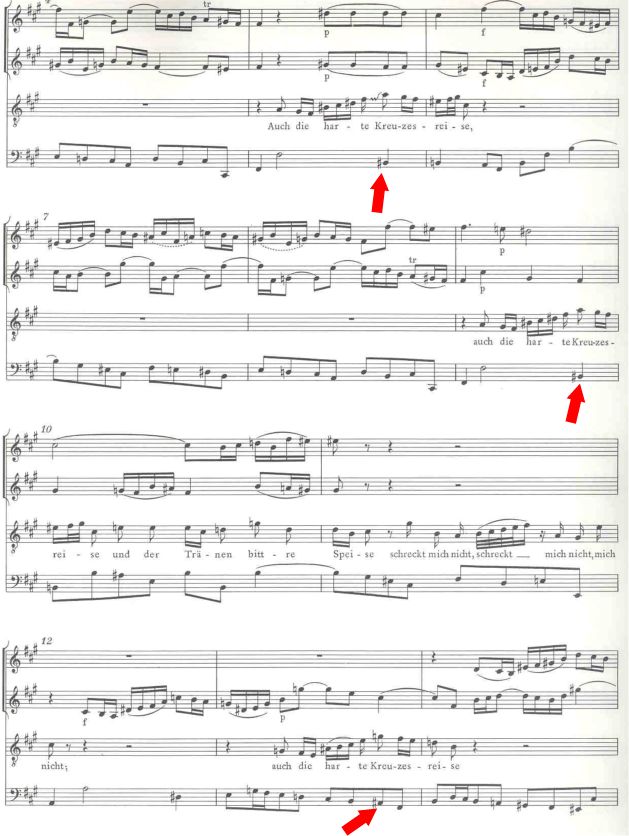
|
|
Mvt. 4 Bass Recitative Kein Höllenfeind kann mich verschlingen
The continuo begins with a strong accent on G# and the voice does not finish the segment "Höllen" without touching the G# as well. |
|

|
| |
|
BWV 3 Ach Gott, wie manches Herzeleid Mvt. 3 Bass Aria Empfind ich Höllenangst
Although part of a compound noun, the segment "Höllen" is accented and has A# in vocal and continuo parts. |
|
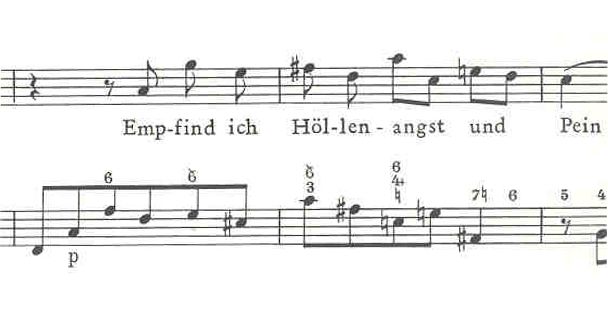
|
|
The second example from this aria shows a double sharp in the continuo just before another entrance, otherwise G#,F# also occur with the word. |
|
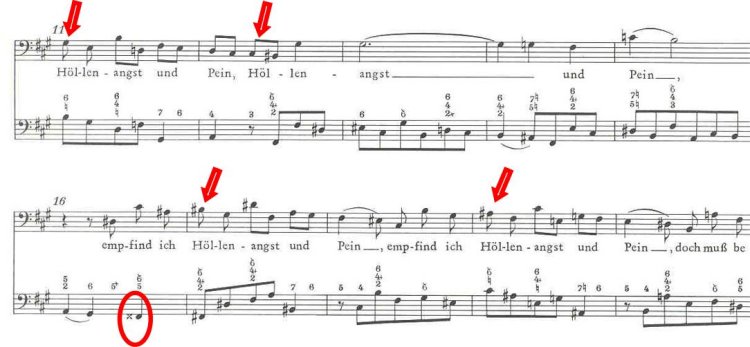
|
|
The only other double sharps are shown here in the third example in the second (middle) section of the aria along with other #'s where the word "Schmerzen"='pains' appears. |
|

|
|
Mvt. 5 Soprano and Alto Duetto Aria Wenn Sorgen auf mich dringen
The first time the phrase "Mein Kreuz hilft Jesus tragen" in the middle section in example one, the key signature already has sharps for both voices and instruments all over, but things get very interesting in the second example taken from the middle section before the Da capo. Both examples given together, so check the measure number when viewing. |
|

|
| |
|
BWV 92 Ich hab in Gottes Herz und Sinn Mvt. 1 chorale movement
When the melody line in the soprano voice has “Kreuz”, its foundation is built upon the continuo with a G#. |
|

|
|
Mvt. 5 Tenor Recitative Wir wollen nun nicht länger zagen
This time the voice has the G# on the high note. Look at all the #'s. The voice part is lifting the cross "Kreuz" on all those #'s. |
|
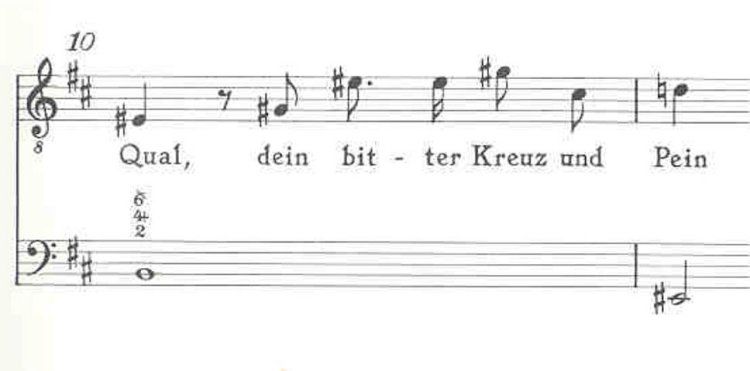
|
|
Mvt. 6 Bass Aria Das Stürmen/Brausen von den rauhen Winden
On the first of three occurrences of "Kreuz" in the middle section of the aria, the voice has the # on the strong accent at beginning of the measure. |
|

|
| |
|
BWV 127 Herr Jesu Christ, wahr' Mensch und Gott Mvt. 1
It is in the chorale melody, but Bach tries to 'raise' the 'cross' by using a natural sign. |
|

|
| |
|
BWV 85 Ich bin ein guter Hirt Mvt. 4 Tenor Recitative Wenn die Mietlinge schlafen
"Höllenwolf" a compound with "Höllen" in an unaccented position at the end of a measure. |
|

|
|
Mvt. 5 Tenor Aria Seht was die Liebe tut
The first of three occurrences of the compound noun ,"Kreuzesstamm," has the continuo 'erect' the cross on the F# and the word 'Kreuz' is accented at the beginning of the measure. The other two instances are unaccented in the middle or end of a measure. There more emphasis is on the 'spilling' of blood. |
|
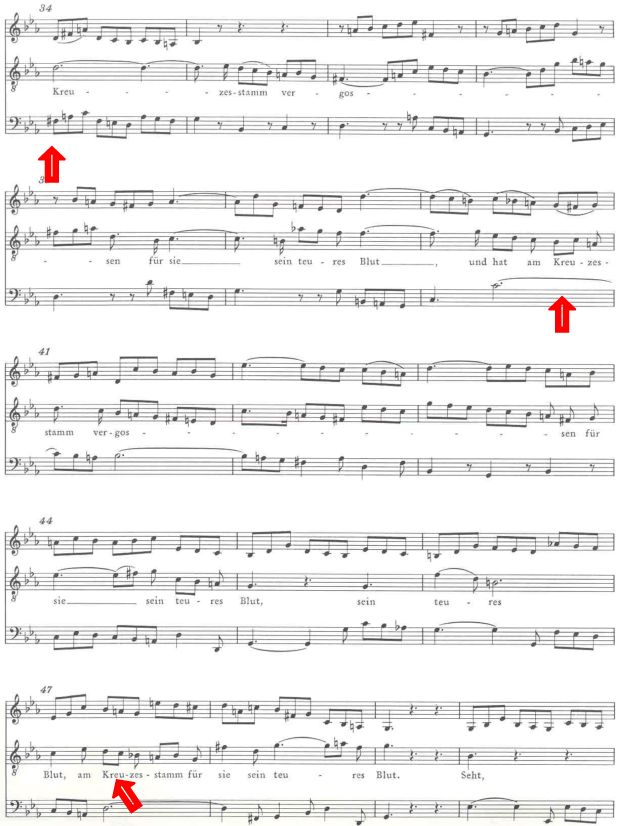
|
|
Three examples are extracted from the page for easier viewing. |
|

|
| |
|
BWV 74 Wer mich liebet, der wird mein Wort halten Mvt. 7 Alto Aria Nichts kann mich erretten von höllischen Ketten
The adjective "höllischen" is repeated six times with no emphasis on the adjective, but rather on the noun "Ketten" each time.Only one example given. |
|

|
| |
|
BWV 175 Er rufet seinen Schafen mit Namen Mvt. 6 Bass Aria Öffnet euch, ihr beiden Ohren
The middle section of the aria has three repeated occurrences of "Kreuz" of which the first is significant. It does have a 'cross' # (E#!) in the voice part. |
|
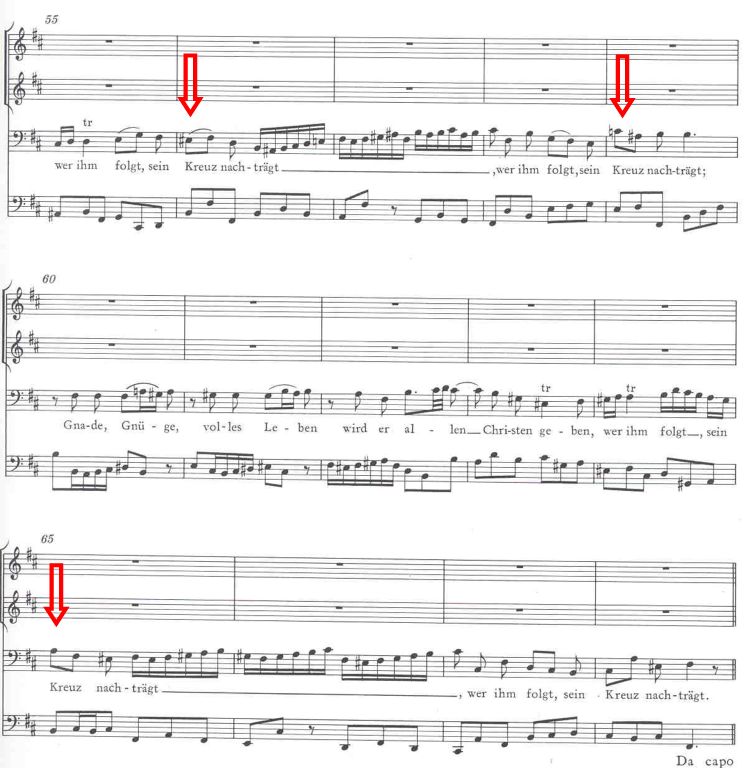
|
| |
|
3rd Leipzig Year 1725-6 |
|
BWV 110 Unser Mund sei voll Lachens Mvt. 4 Alto Aria Ach Herr, was ist ein Menschenkind
Only instances of double sharp in the mvt. and cantata. |
|

|
|

|
|
Mvt. 7 Tenor Aria Christenkinder, freuet euch
"Höllen" in a compound noun with "Reich" in an unaccented position (Example missing, but not important). |
| |
|
BWV 57 Selig ist der Mann, der die Anfechtung duldet Mvt. 2 Soprano Recitative Ach! dieser süßer Trost
Notice the F# in the continuo with "Wurm" also what happens with 'Wolves'. |
|

|
|
Mvt. 3 Soprano Aria Ich wünschte mir den Tod
"Höllennot -" "Hölle" is in a compound, functions as an adjective, is in an unaccented position, the main emphasis is on "Not" to rhyme with "Tod". |
|

|
| |
|
BWV 72 Alles nur nach Gottes Willen Mvt. 4 Bass Recitative So glaube nun
Two instances that follow the rule: the cross (D#) is raised on the foundation of the continuo. The second time "Kreuzesband" is in a compound, not as strong as the individual word in the first instance but based on a C# in the continuo. |
|
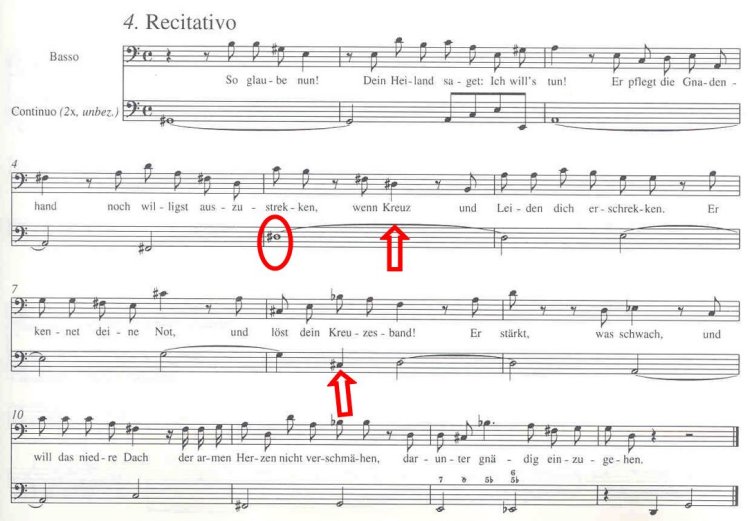
|
| |
|
BWV 170 Vergnügte Ruh, beliebte Seelenlust Mvt. 1 Alto Aria
This has a noun compound "Höllensünden" at the end of a measure in an unaccented position, but the first syllable goes to a sharp anyway and there are other sharps in the vicinity. |
|
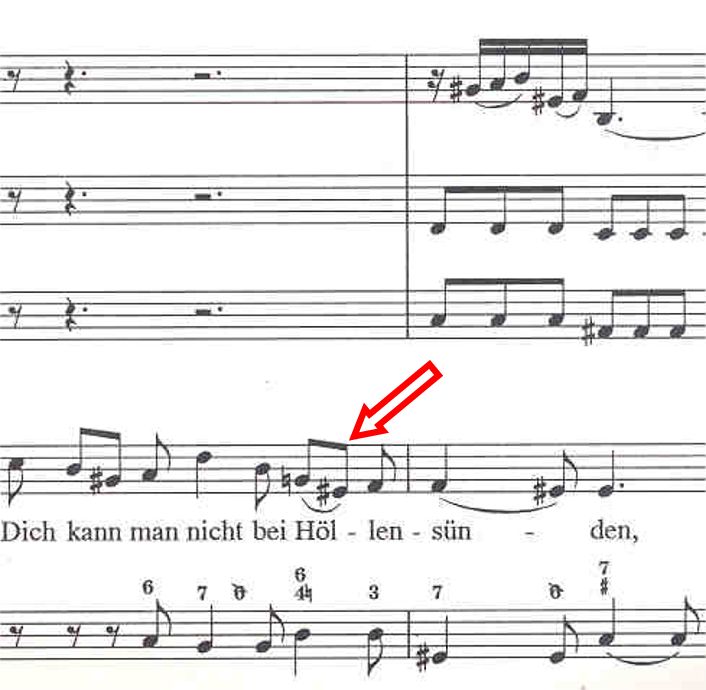
|
|
Mvt. 2 Alto Recitative Die Welt, das Sündenhaus
"Höllenlieder" is a compound noun in an unaccented position on sixteenth notes. |
|

|
| |
|
BWV 19 Es erhub sich ein Streit Mvt. 1
"höllische" an adjective in the midst of numerous entries. |
|

|
|
Mvt. 4 Tenor Recitative Was ist der schnöde Mensch, das Erdenkind?
"Wurm" with a sharp, but not double sharp. |
|

|
| |
|
BWV 47 Wer sich selbst erhöhet, der soll erniedriget werden Mvt. 3 Bass Recitative Der Mensch ist Kot, Staub, Asch und Erde
"Wurm" shows nothing here. |
|

|
|
Mvt. 4 Bass Aria Jesu, beuge doch mein Herze
"Höllenbrand" is a compound noun used twice in this aria in an unaccented position. The downward movement is the most important here. |
|

|
| |
|
BWV 169 Gott soll allein mein Herze haben Mvt. 4 Alto Recitative Was ist die Liebe Gottes?
"Hölle" (a C# in the vocal line) is unaccented on the way down and the last note at the bottom is an A# in the vocal line. |
|
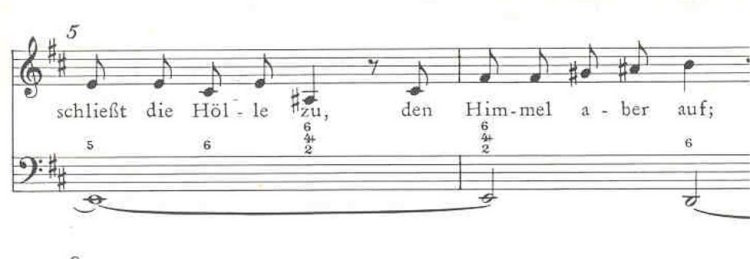
|
| |
|
BWV 56 Ich will den Kreuzstab gerne tragen Mvt. 1 Bass Aria
The classic example "Kreuzstab" although a compound noun is accented on "Kreuz-" with a C# at the beginning of the measure and the upward movement of the notes reinforces the idea of trying to heave the cross upwards. |
|
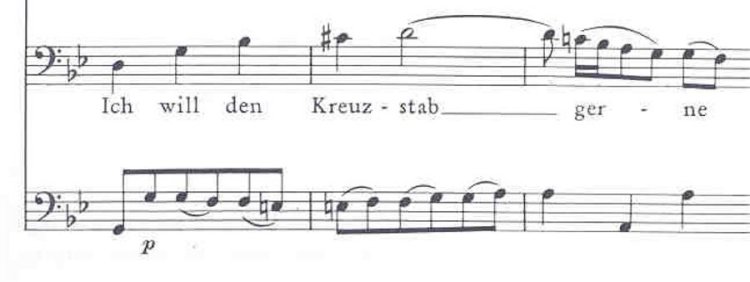
|
|
Mvt. 2 Bass Recitative Mein Wandel auf der Welt
Notice the key signature key of Bb and when "Kreuz" is sung on the first, main beat of the measure as a single word detached from the words that follow, the continuo has the classic F# as the basis upon which the 'cross' ='Kreuz'=the sharp (accidental note) is erected or lifted up. |
|

|
| |
|
BWV 98 Was Gott tut, das ist wohlgetan Mvt. 4 Alto Recitative Gott hat ein Herz
"Kreuz" is unaccented here but does maintain the C# from the word before it. |
|

|
| |
|
BWV 55 Ich armer Mensch, ich Sündenknecht Mvt. 2 Tenor Recitative Ich habe wider Gott gehandelt
"Höll" in an unaccented position - nothing here. |
|
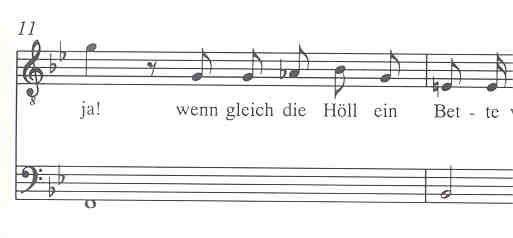
|
| |
|
1727 |
|
BWV 58 Ach Gott, wie manches Herzeleid Mvt. 3 Soprano Aria Ich bin vergnügt in meinem Leiden
First of four repeated occurrences shows the typical feature with the voice having the sharp (C#) as the word "Hölle” is accented in the middle the measure. The article 'die' is the upbeat to "Hölle" Notice the F# in the continuo right after the accent. |
|

|
| |
|
1729 |
|
BWV 174 Ich liebe den Höchsten vom ganzen Gemüte Mvt. 3 Tenor Recitative O Liebe welcher keine gleich!
In a somewhat unaccented position at the end of the measure, the sharp sign nonetheless appears with "Höllenpforte", a compound noun and is reechoed by the strings. |
|

|
|
|
1730 |
|
BWV 51 Jauchzet Gott in allen Landen Mvt. 1 Soprano Aria
Two out of three instances of "Kreuz" are both adequately marked with #'s and for the one that does not have a # in the vocal part , look at the F# and G# in the trumpet part and D# in the vocal part. |
|
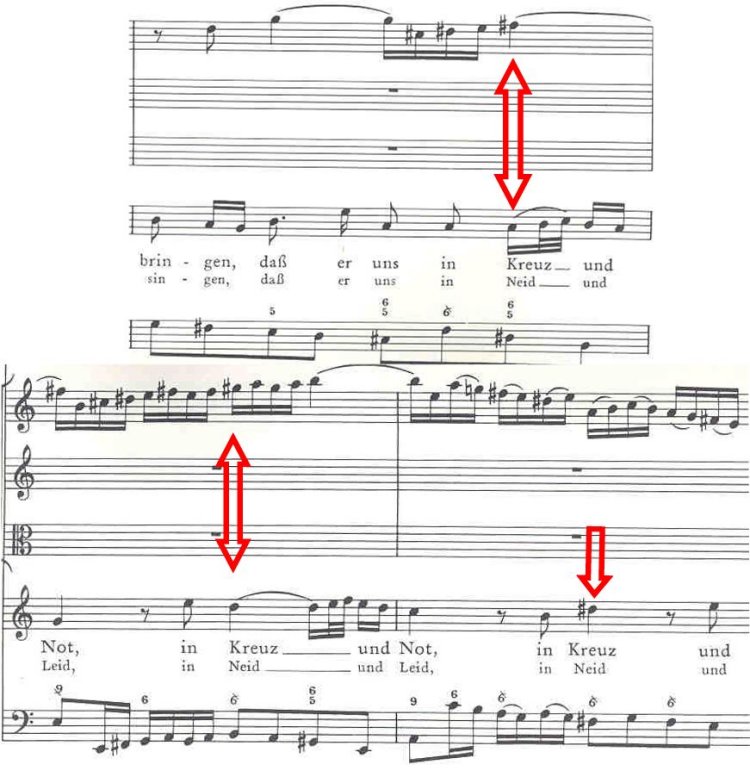
|
| |
|
Unknown Date |
|
BWV 69 Lobe den Herrn, meine Seele Mvt. 4 Tenor Recitative Der Herr hat große Ding an uns getan
Although "Kreuz” is unaccenthere, "Kreuz" is on a C# and note all the #'s that follow. |
|
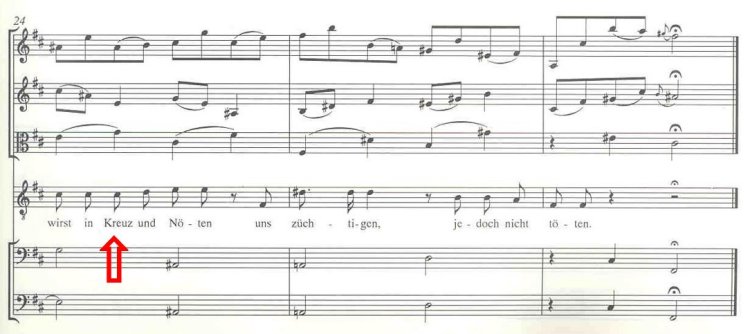
|
|
Mvt. 5 Bass Aria Mein Erlöser und Erhalter
"Kreuz" is repeated three times in this aria. The example shows the first instance with a sharp in the vocal line. |
|

|
| |
|
BWV 122 Das neugeborne Kindelein Mvt. 4 Soprano, Alto, Tenor Aria (with Alto having the chorale melody) Ist Gott versöhnt und unser Freund
“Höllenpfort" another compound in which 'Höllen' is more adjectival and the emphasis is on 'pfort' Also in a chorale melody itself where not much can be done. |
|
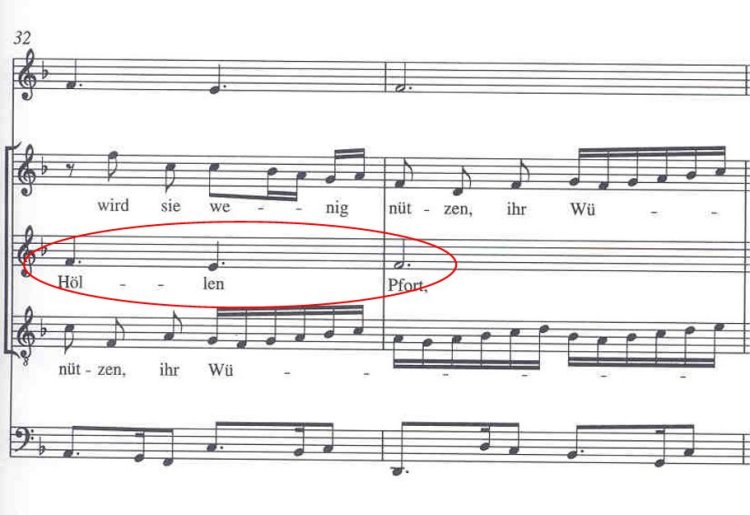
|
| |
|
BWV 146 Wir müssen durch viel Trübsal Mvt. 6 Tenor Recitative Ich bin bereit mein Kreuz geduldig zu ertragen
Remember how close this thought was to Bach (the letter referred to above). Even in the unaccented position of a measure the voice has the 'raised cross', G#, on the word "Kreuz" |
|
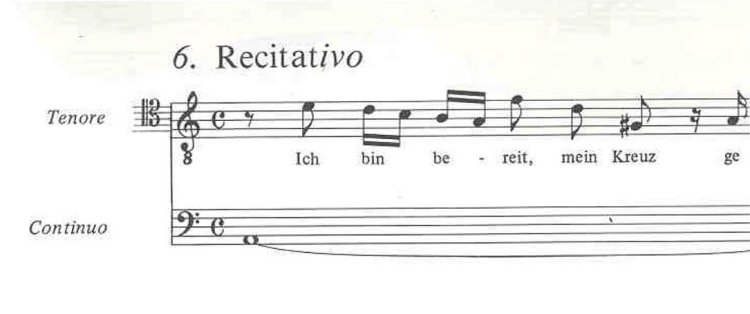
|
|
A good example. |
| |
|
BWV 158 Der Friede sei mit dir Mvt. 4 Chorale Hier ist das rechte Osterlamm
"Kreuzes Stamm" is almost a compound noun here in a repeated section, where other words prevail in the first line. The italicized words indicate that Bach did not even write these words into the score. |
|

|
| |
|
BWV 159 Sehet, wir gehn hinauf gen Jerusalem Mvt. 1 Alto and Bass Arioso and Recitative
Two examples, one of "Kreuz", the other of "Hölle" in unaccented positions and nothing unusual occurs. With "Hölle" Bach is more interested in showing musically the downward motion toward hell. |
|
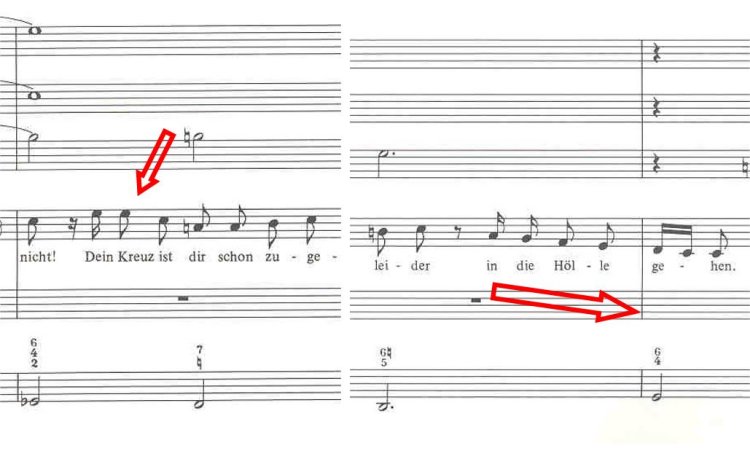
|
| |
|
BWV 171 Gott, wie dein Name, so ist auch dein Ruhm Mvt 3 Alto Recitative Du süßer Jesus-Name du
Although there are other sharps in the continuo as well as the vocal line, this is the only A#. "Kreuz" is in an accented position at the beginning of the measure. |
|
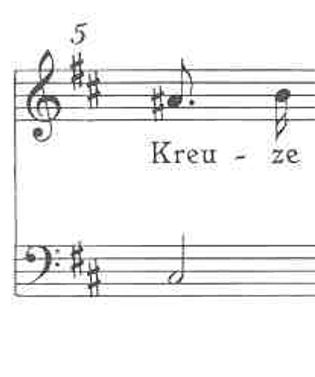
|
| |
|
BWV 188 Ich habe meine Zuversicht Mvt. 4 Alto Aria Unerforschlich ist die Weise
"Kreuz" appears four times in this aria. The first two instances are given and reveal the presence of G#'s in the vocal part. |
|

|
| |
|
BWV 244 SMP
What is worse than #'s = "Kreuz?" The double-sharps at the point of Jesus' betrayel by Judas. |
|
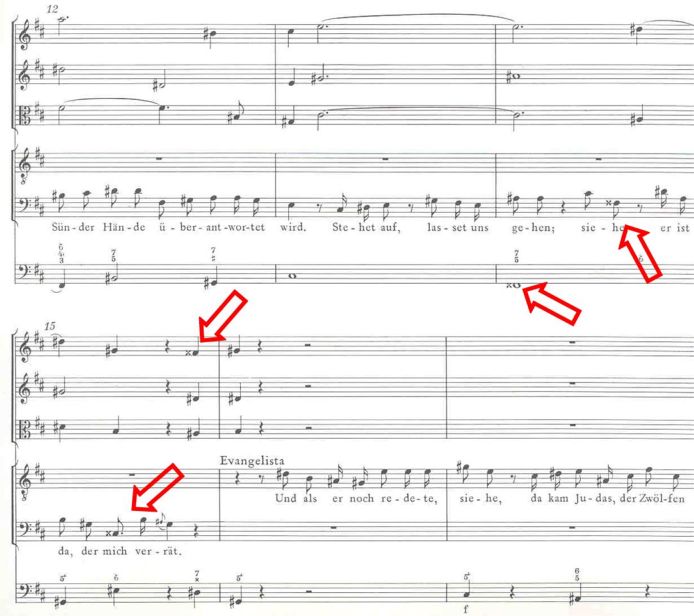
|
|
'Krankheit' is illustrated thus. |
|

|
|
"Laß ihn kreuzigen" has the # in exactly the correct position |
|
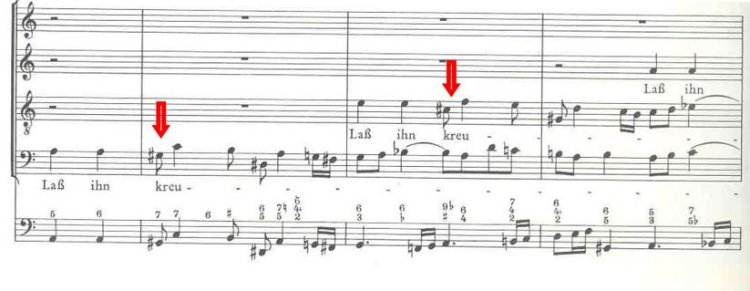
|
|
the fugal entries land right on the # with the word 'kreuz-". |
|
-- |
|
All snippets taken from various volumes of the NBA too numerous to mention. |
|
Copyright © All rights of the article belong to Thomas Braatz (April 2001). No part of this article may be reproduced, stored in a rerieval system, or transmitted, in any form or by any means, electonic, mechanical, photocopying, recording or otherwise, without the prior permission of the author. |
| |
|
Feedback to this Article |